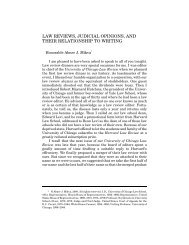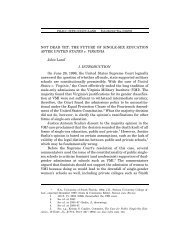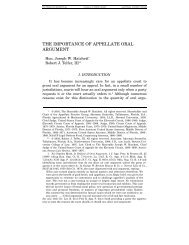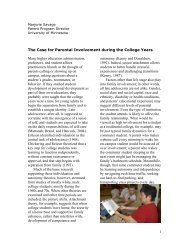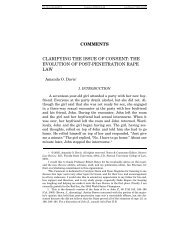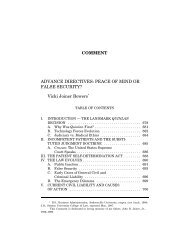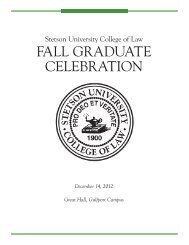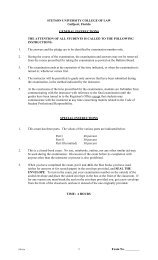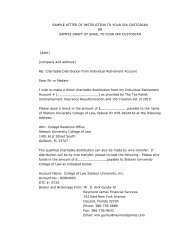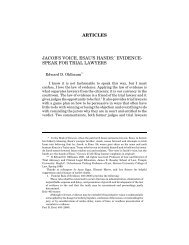Student Success, Retention, and Graduation: Definitions, Theories ...
Student Success, Retention, and Graduation: Definitions, Theories ...
Student Success, Retention, and Graduation: Definitions, Theories ...
You also want an ePaper? Increase the reach of your titles
YUMPU automatically turns print PDFs into web optimized ePapers that Google loves.
Noel-Levitz <strong>Retention</strong> Codifications<strong>Student</strong> <strong>Success</strong>, <strong>Retention</strong>, <strong>and</strong> <strong>Graduation</strong>:<strong>Definitions</strong>, <strong>Theories</strong>, Practices, Patterns, <strong>and</strong> TrendsNovember 2008Page 12experience relatively higher dropout rates. Special programs <strong>and</strong> efforts can besuccessful in addressing students’ needs, reducing isolation <strong>and</strong> facilitating integrationin the academic community, <strong>and</strong> thereby helping to ensure student success <strong>and</strong>retention.Undecided students. <strong>Retention</strong> research identifies this group as being highly dropoutprone.Lack of clearly defined educational or career goals is often the main reasonstudents give for not returning or pursuing a college degree. Programs targetedspecifically for undecided students have proven to significantly reduce attrition rates.Early alert. Prediction of dropout-prone students when combined with early warningstrategies <strong>and</strong> support programs can increase retention.Policies/procedures. Colleges <strong>and</strong> university whose policies <strong>and</strong> procedures arealigned with the institutional mission <strong>and</strong> reflect student-centeredness, <strong>and</strong> arecommitted to continuous improvement usually demonstrate higher retention rates.Faculty/staff development. The frequency <strong>and</strong> quality of faculty/staff <strong>and</strong> studentinteractions has been shown to contribute positively to student retention. In-servicefaculty/staff development efforts resulting in more competent, caring, <strong>and</strong> concernedindividuals are critical to successful retention initiatives/programs.Internal marketing programs. During the recruitment process campuses communicatewith students regularly keeping them informed of changes occurring on the campus <strong>and</strong>providing general information about campus life. Once students arrive on campus,internal communication often stops. Ongoing communication can have a positiveimpact on the persistence of some students because they stay in touch with currentcampus events <strong>and</strong> developments. In addition, ongoing communication with the faculty<strong>and</strong> staff is vital to fostering learning of the entire campus.First Year Experience course. Many successful first-year retention programs stemfrom the creative teams of mentors/instructors who participate in some type of first-yearexperience course. This course is generally focused on time, life, <strong>and</strong> study skills, <strong>and</strong>has a career exploration component. The essential goal of the First-Year Experience orUniversity 101 course is to maximize the student’s potential to achieve academicsuccess <strong>and</strong> to adjust responsibly to the individual <strong>and</strong> interpersonal challengespresented by collegiate life.Sophomore strategies. Next to improving the freshman-to-sophomore return rate,campuses increasingly have been focusing on reducing the sophomore-to-junior dropoutrates by implementing strategies to support second-year students. These supportprograms usually center on helping students who are still undecided determine anacademic major <strong>and</strong> assisting students in creating clear career objectives related to theirmajors.Junior jaunt. Determine strategies that lessen the number of junior status students thatleave the institution. This process requires creating specific strategies designed typicallyby academic program fostered around degree completion <strong>and</strong> career goal obtainment.Engagement <strong>and</strong> satisfaction. Underst<strong>and</strong>ing the undergraduate student experience iscentral to promoting student learning, success, <strong>and</strong> educational attainment. Measuring astudent’s levels of satisfaction <strong>and</strong> levels of engagement in the academic <strong>and</strong> social



